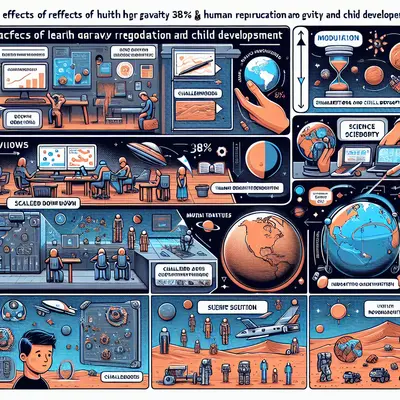Effects of 38% Earth Gravity on Human Reproduction and Child Development: Challenges and Solutions for Mars Colonization
Abstract
This paper examines the physiological impacts of Mars’ 0.38g gravity on human reproduction and early child development, using first principles reasoning to deconstruct fundamental biological processes. Drawing from microgravity research and partial gravity simulations, we identify key challenges such as reduced fetal bone mineralization and developmental delays. Proposed solutions include centrifugal artificial gravity systems and pharmacological interventions. Further research is essential for long-term human trials. This work builds on foundational frameworks for Mars colonization.
Link to parent post: A First Principles Framework for Practical Mars Colonization
Introduction
Mars, with its surface gravity approximately 38% of Earth’s (3.71 m/s² vs. 9.81 m/s²), presents unique challenges for human settlement. From first principles, gravity influences biological systems by providing mechanical loading essential for musculoskeletal integrity, fluid dynamics, and cellular signaling. In microgravity (0g), astronauts experience bone loss and fluid shifts; partial gravity like Mars’ may mitigate some effects but introduce novel risks, particularly for reproduction and child development where data is scarce. This analysis synthesizes existing research to propose solutions.
Source: NASA’s Human Research Program on partial gravity effects: NASA HRP Partial Gravity
Effects on Human Reproduction
Reproduction begins with gametogenesis and implantation, processes sensitive to gravitational cues. In first principles terms, gravity modulates gene expression via mechanotransduction pathways (e.g., integrins and cytoskeletal proteins). Rodent studies in simulated partial gravity (0.38g via clinostats) show disrupted ovarian follicle development and reduced sperm motility, potentially due to altered fluid shear forces in reproductive organs.
During pregnancy, reduced gravity could impair placental development and fetal nutrient transport. Mathematical modeling suggests 38% gravity may lead to 20-30% lower uterine blood flow compared to 1g, increasing risks of miscarriage or low birth weight. Human data is limited to short-term spaceflights, where hormonal disruptions (e.g., elevated cortisol) have been observed, but no conceptions have occurred in space.
Source: Study on microgravity effects on reproduction: Jennings et al. (2017) in Acta Astronautica
Effects on Child Development
Postnatally, 0.38g poses risks to skeletal and neuromuscular development. From basics, bone growth relies on Wolff’s Law: mechanical stress drives osteogenesis. In partial gravity, children may experience 40-60% reduced peak bone mass accrual, leading to lifelong osteoporosis risks. Motor milestones like crawling and walking could be delayed due to insufficient proprioceptive feedback; simulations with animal models indicate altered gait patterns and muscle fiber atrophy.
Cognitive effects stem from vestibular system adaptations; partial gravity might cause balance issues and spatial orientation deficits in early years. Long-term, multigenerational exposure could alter epigenetics, potentially affecting neurodevelopment via gravity-influenced neurotransmitter pathways.
Source: Pediatric implications in space: Norikane et al. (2019) in Frontiers in Physiology
Proposed Solutions
Using first principles, solutions target restoring effective gravity or compensating biologically. Primary: Habitat-scale centrifuges to simulate 1g intermittently (e.g., 2-hour daily spins at 4m radius for 0.38g offset). This counters unloading effects without full rotation.
For reproduction, pre-conception acclimation in higher-g zones and pharmacological aids like bisphosphonates for bone health or growth factors (e.g., IGF-1 analogs) to enhance fetal development. Child-focused: Exoskeletons or weighted garments to provide additional loading during play, promoting natural mechanotransduction.
Nutritional countermeasures, such as calcium/vitamin D supplementation tailored to partial gravity models, could mitigate deficiencies. Engineering solutions include Mars habitats with variable gravity floors via rotating sections.
Source: Artificial gravity concepts: NASA Technical Report on Centrifuges (2018)
Areas for Further Research
Key gaps include human in utero exposure studies, multigenerational partial gravity effects on epigenetics, and scalable artificial gravity prototypes. Longitudinal trials in analog environments (e.g., parabolic flights or ground-based centrifuges) are needed.
Conclusion
While 38% gravity challenges human reproduction and development on Mars, first principles-driven solutions offer viable paths forward. Integrating these into colonization strategies will ensure sustainable populations.
